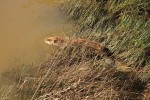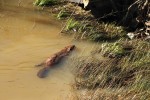Sniff, I’m so proud. Reader Kevin just commented that the ‘beaver’ shirt from Australia isn’t a beaver. Shh, we know. But it’s really cute, and the country doesn’t have beavers so we can’t expect them to recognize one. I’m just so touched that all my beaver suspicion and mockery over the years has made folks attentive to this issue on their own! And they say one person can’t make a difference.
Aw, you guyssssssssss.
I remember, years ago, when I attended my first beaver conference. Afterwards I went to their airport glowing with the warm-haze of beaver believer-ing and met a man from a southern state waiting for the shuttle. (Let’s call him the good ole boy.) When he pressed to inquire what conference I was at, he said smartly, “I work for the railroads and we don’t have any problems with beaver in my state.” (Here he made a gun with his thumb and forefinger and clicked the trigger twice) “Problem solved!”
And I remember thinking to myself, “Toto, I don’t think we’re in Kansas anymore.”
I offer this story to introduce you to this mornings news which is pretty much the opposite of everything I’ve been writing for the past week. I guess it’s natures way of reminding us not to get comfortable and lazy. There’s still plenty of work to do.
Beaver Dam Gone, Roxbury Residents Now Eager for Brook Cleanup
ROXBURY, NJ – Chronic flooding due to beaver dams on Succasunna Brook might have weakened trees, which are now threatening to fall onto some Roxbury residents’ properties, a situation that prompted the residents to complain to Roxbury officials. The residents, primarily on Paul Drive in Succasunna, live adjacent to a flat and low wetland bisected by the brook just upstream from Midland Pond. Concerned about the trees, as well as the overall condition of Succasunna Brook, the residents recently sought help from Roxbury Councilman Dan Kline.
“The beavers were blocking Succasunna Brook last summer,” he said in an interview Monday. “The water rose two to two-and-a-half feet in the area upstream of the dam.”
Blood said the beavers built an impoundment that “extended from the Midland Pond property all the way across to Paul Drive.” He said the structure was a couple hundred feet long and ranged in height from 18 inches to three feet.
“Every night we tore it apart and in the morning it would be back,” he said.
The beavers are now gone, thanks to the efforts of some trappers, and the dam was removed this month by the Morris County Mosquito Commission, Blood said.
Blood and Raths said the township is working with a company that uses drones to conduct aerial videotaping. This will enable township officials to see further beaver dams or other “snags” along the course of the river that need to be removed.
The entire community banding together to kill beavers! It brings a tear to my eye. Why stop with just using drones to spot beaver dams? Why not shoot them directly from the air? It works for terrorists I understand. (And wedding parties.) So the whole community is so grateful that their rights to maintain drought and erosion have been protected by their tax dollars that they came by Councilman Kline’s office just to say ‘thank you”. That’s mighty civic of them. They’ll have even more to thank him for with the reduced nesting habitat this spring because of all that dead tree removal. I’m sure the fish would thank them personally but they’re already washed downstream in New York by now. (That is if the sediment hasn’t clogged their gills completely.)
And seriously, “Blood and Raths“??? You hired a company run that employs men named“Blood and Raths“??? Are you kidding me??? If I made UP those names my publisher would object because they sound too obviously villainous. Is this a Lemony Snicket chapter? Is Count Olaf going to come leaping out from behind one of those dead trees and announce that we shouldn’t worry about our town because he is the mayor and he will protect it with his two special guardians, Mr. Blood and Mr. Raths?
If you’re going to pay to shoot beavers from the air, and pretend this is protecting the community, at the very least you could have the decency to choose some deceptively well-intentioned names. Like “Baby-saver and Hero” or something. Or the Clean Water Act. Sheesh.
There were literally 5 trapping articles on my news feed this morning, but that’s all I can stand for one day. Jon noticed there is a netflix series now loosely following the beaver trade in early North America. I tried dimly to watch it but it is so thick with blood, cliche, testosterone and bad accents that I couldn’t stomach it. The credits, however, have a moment that might interest you. Although I am fairly certain no trapper ever used a musket to catch beaver.


.jpg) ts in Upper Lydbrook and Lydbrook how experts believe putting beavers into Greathough Brook in the Forest could help halt water gushing down the hillsides.
ts in Upper Lydbrook and Lydbrook how experts believe putting beavers into Greathough Brook in the Forest could help halt water gushing down the hillsides. “Beavers have been managing water for millions of years; they’re adapted to do a far better job than us,” he said. “We can no longer pay to maintain flood walls and flood defences so beavers are a rational option when it comes to water management and flood control.”
“Beavers have been managing water for millions of years; they’re adapted to do a far better job than us,” he said. “We can no longer pay to maintain flood walls and flood defences so beavers are a rational option when it comes to water management and flood control.”.JPG) w of water which can lead to flash flooding.
w of water which can lead to flash flooding.














































